Email marketing campaigns vs email blasts: Which is best?

Emails come in a variety of shapes, sizes, and styles. Some email campaigns feature promotional messages brimming with gifs, videos, and discounts that grab your customer’s attention.
Other emails are all about generating peace of mind for your clients, letting them know that their products are on the way after a purchase, or confirming a sale.
Where many companies go wrong, is they assume all emails are the same.
When you’re trying to create the best email campaigns for your needs, it’s important to ensure that you’re using the right messages at the correct times.
Some relationship-building strategies, for example, will demand drip email campaigns that last for weeks, months, or even years.
Other interactions with your audience may only need a single interaction in the form of a one-off message: an email blast.
Today, we’re going to help you identify the difference between full email campaigns, and one off blasts, so you can make the best choice.
Email marketing campaigns vs one off blasts
Email marketing campaigns and “blasts” are defined often by their longevity.
With a one-off email, you send a single message with no follow up. For instance, you might send an email to your target audience that informs them of an event that’s coming up in your schedule.
Once that event is over, there’s no reason to follow up again.
With drip email campaigns, you “drip feed” messages to your audience for a specific purpose. You might use a campaign to build customer loyalty, or to encourage a new client to purchase something from your brand.
With email marketing campaigns, for instance, a car retailer might send a message at the beginning of the year about getting a tune up or deliver a discount when it gets closer to the time for the car’s MOT.
After a couple of years, the same retailer could follow up with a message about saving money on a trade-in for a new vehicle.
Email campaigns can have various triggers associated with them to determine what someone needs to do before a message arrives in their inbox. For example, you might have campaign that starts with someone making a purchase or arranging a booking.
What are email blasts?
Companies can often struggle to figure out where an email blast ends, and a drip campaign begins. What transforms a standard series of one-off emails into a campaign?
While you may eventually send another email to your customer that seems similar to the first blast you delivered, an email blast is something you send with absolutely no intention of any follow up.
It’s common for companies to use email blasts when they’re announcing flash sales, for instance. If you’re sending your subscribers an exclusive message about a new offer, or you’re announcing the arrival of a new product, maybe all you need is a single email.
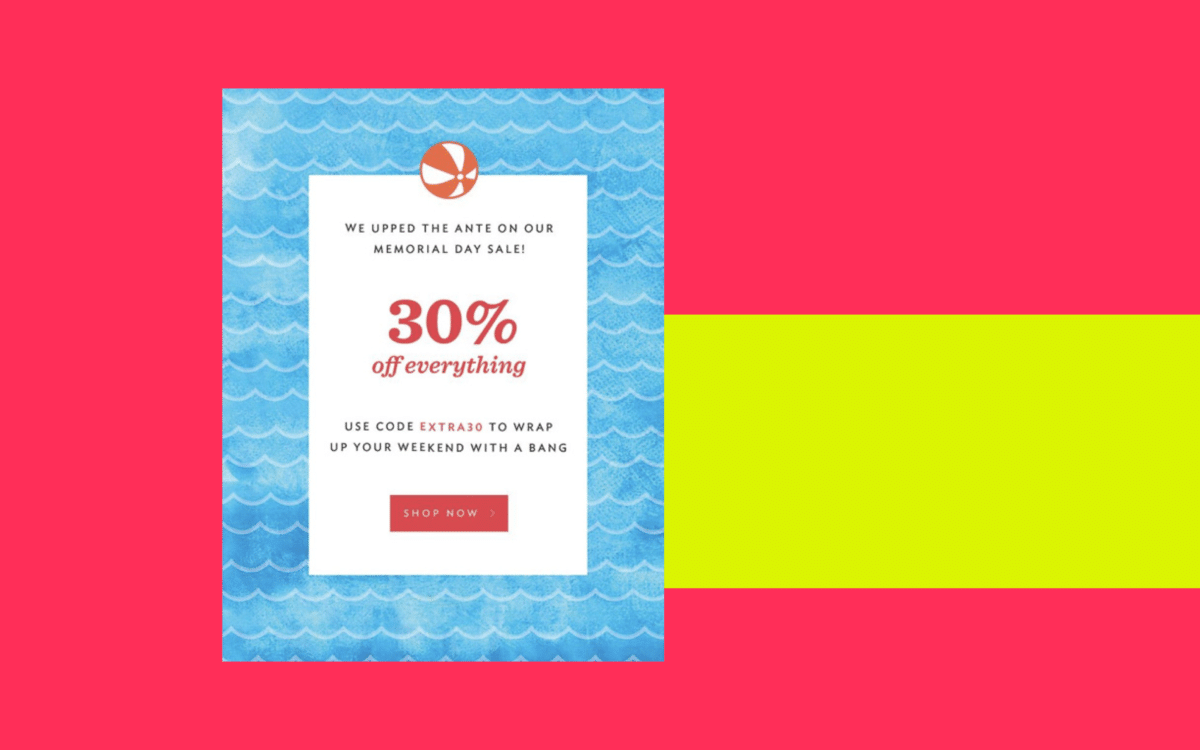
With a one-off email blast, you don’t build a relationship with a customer or have a conversation over time. These one-off messages are like announcements. They’re a chance to connect with your client and share information fast.
There are a few rare circumstances when an email blast might make sense. If you’re just informing your audience about a one-off sale, then you probably don’t need an entire campaign building up to that.
You can also send single emails to your customers to thank them for a purchase, but it’s usually much more effective to follow up with a full after-sales email strategy.
The common reasons to use an email blast include:
- An announcement: If you’re announcing something that has no connection to your other offers or campaigns right now, like an exclusive last-minute sale, a one-off email blast might be the best choice.
- A message from your team: If something happens in your current landscape, like a sudden disaster or crisis, you can send a single message from your team explaining what you’re doing about the issue. This usually won’t require additional campaigns.
- News posts: If something recently happened to your brand, like you’ve received a new round of funding, or an investor got involved, you might want to let your customers know with a quick email blast.
Most of the time, however, email marketing campaigns work best when they’re a comprehensive strategy of interwoven messages, designed to develop a conversion with your audience that may eventually lead to sales, brand loyalty, and more.
What are drip email campaigns?
If a one-off email blast is an opportunity to announce something to your customers, an email campaign is more of an intimate conversation.
The most successful email campaigns help to build a connection with your customers over time, through messages triggered by specific events.
For instance, welcome emails are a common example of drip email campaigns. With this strategy, companies start by welcoming their customer to their service, and thanking them for signing up.
The initial email usually reminds the customer of why they got involved in the first place, and what they can expect from the relationship going forward:
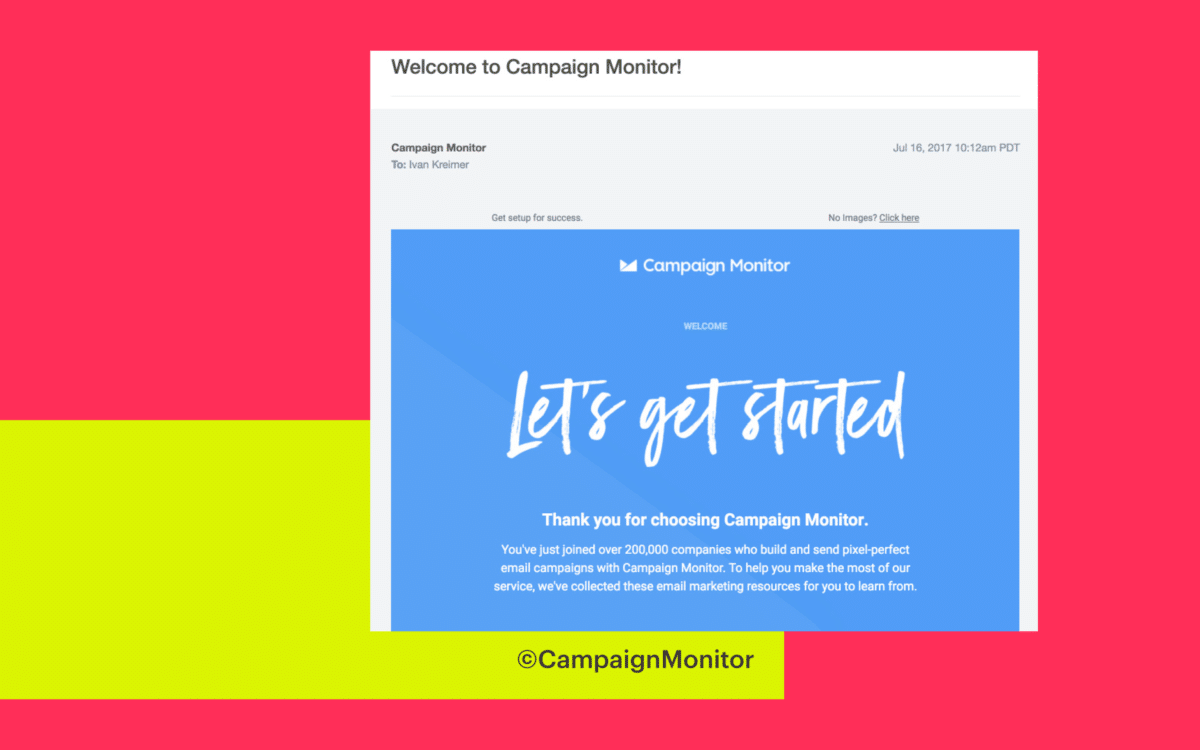
The email immediately tells customers what they can expect now that they’re part of the Campaign Monitor community. Email drip campaigns can cover a range of different interactions with clients.
They might include updates about the latest products you have on sale:
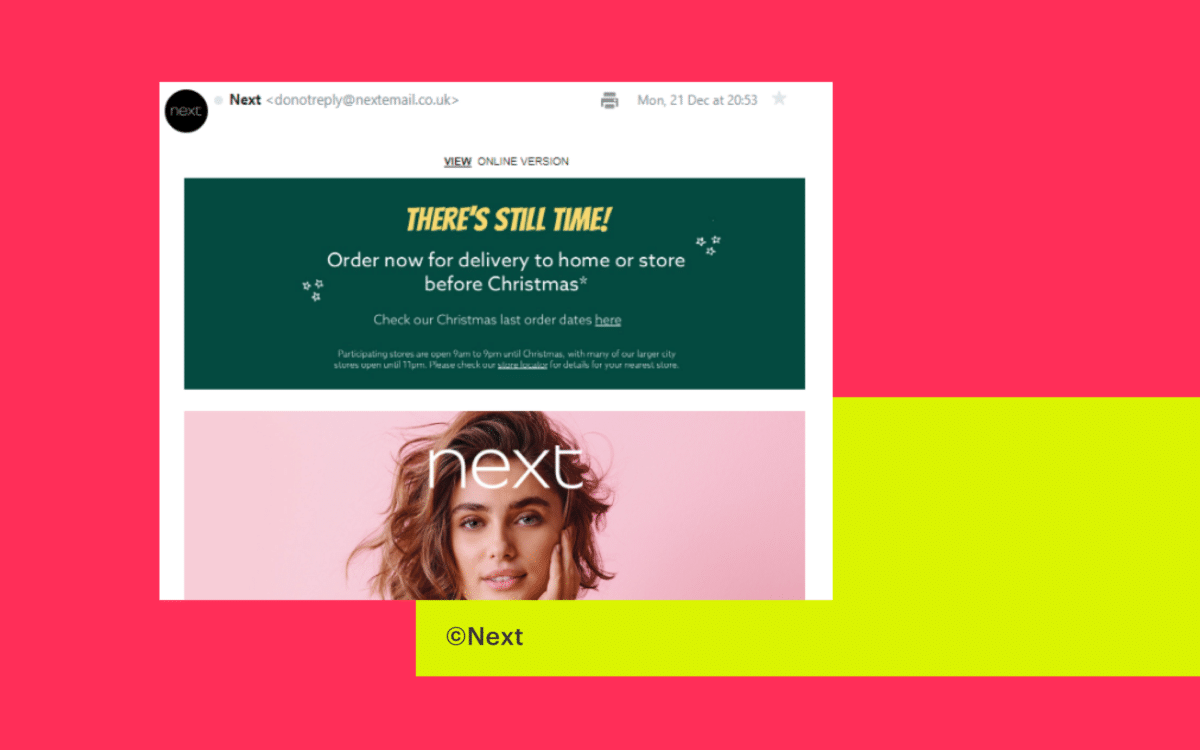
You could also send messages reminding your audience when they’re about to run out of something they purchased recently, or when it might be time to renew a subscription.
The idea of email campaigns is that the conversation lasts for an extended period of time, gradually improving the relationship you have with your customer.
Most companies experiment with a wide variety of emails in their drip campaigns, ranging from emails that feature case studies for social proof, to messages that promote exclusive discount codes for your most loyal clients.
Why are drip email campaigns better than blasts?
Email blasts are problematic because they tend to be one-size-fits-all announcements that don’t appeal to your individual customers.
One of the most important things you can do to make your email marketing more effective is ensure that it appeals directly to each specific buyer persona.
With email blasts, you’re generally getting as much information as possible out to everyone on your list, fast. You don’t tailor a message about your recent response to a global pandemic to each individual customer.
Instead, you send a general announcement that explains what you’re going to do, and how those actions apply to everyone.
This kind of “spray and pray” marketing rarely has the right impact on your customer from an emotional level, because you’re not taking the pain points and unique expectations of each audience member into account.
Alternatively, a trigger campaign directly appeals to a specific audience at specific times in the buyer journey. Done well, your email marketing campaigns send a logical sequence of messages in a way that gradually increases customer loyalty.
The research shows that the more personalized and specific your marketing efforts are (particularly in email), the better your results will be:
- Segmented emails that target a specific customer generate about 58% of all revenue.
- Targeted personalization increases customer engagement according to 74% of marketers.
- Personalized emails deliver up to 6 times higher transaction rates.
- Segmented and personalized emails improve CTR by around 14%.
- Personalizing your email messages increases conversions by 10%.
The research constantly indicates that most consumers prefer to connect with companies via email. However, the majority of your customers want messages that are specific and relevant to their needs. They don’t want mass email blasts that seem like they could go to anyone.
More often than not, these “general” messages get lost within the noise of the inbox, or simply sent straight to spam.

How amazing email campaigns benefit your business
With amazing email campaigns, you can create specific conversational experiences for your customers that have a direct impact on loyalty.
The more your customers see relevant messages from you that are specific to where they are in their customer journey, the more they’ll begin to trust your team. What’s more, thanks to email marketing tools, it’s easier than ever to adapt your emails to the specific needs of your audience.
You can add the first name of your customer to the subject line of the email, the copy, and even the images that you add to your messages.
Because you’ll be able to create unique automated email campaigns with the information you have about each “segment” of your audience, you can also adjust your efforts to suit the needs of each client.
As an example, you might send messages to your most loyal customers that include more upselling and customer loyalty opportunities.
On the other hand, when you’re sending a drip campaign to a new customer, you’d focus first on building the trust they have for your brand, by sharing thought leadership content, and messages that set expectations.
You can even adjust common marketing campaigns slightly based on the products your clients are most likely to be interested in.
Adidas often segments its list on gender, selling male products to men, and female garments to women.
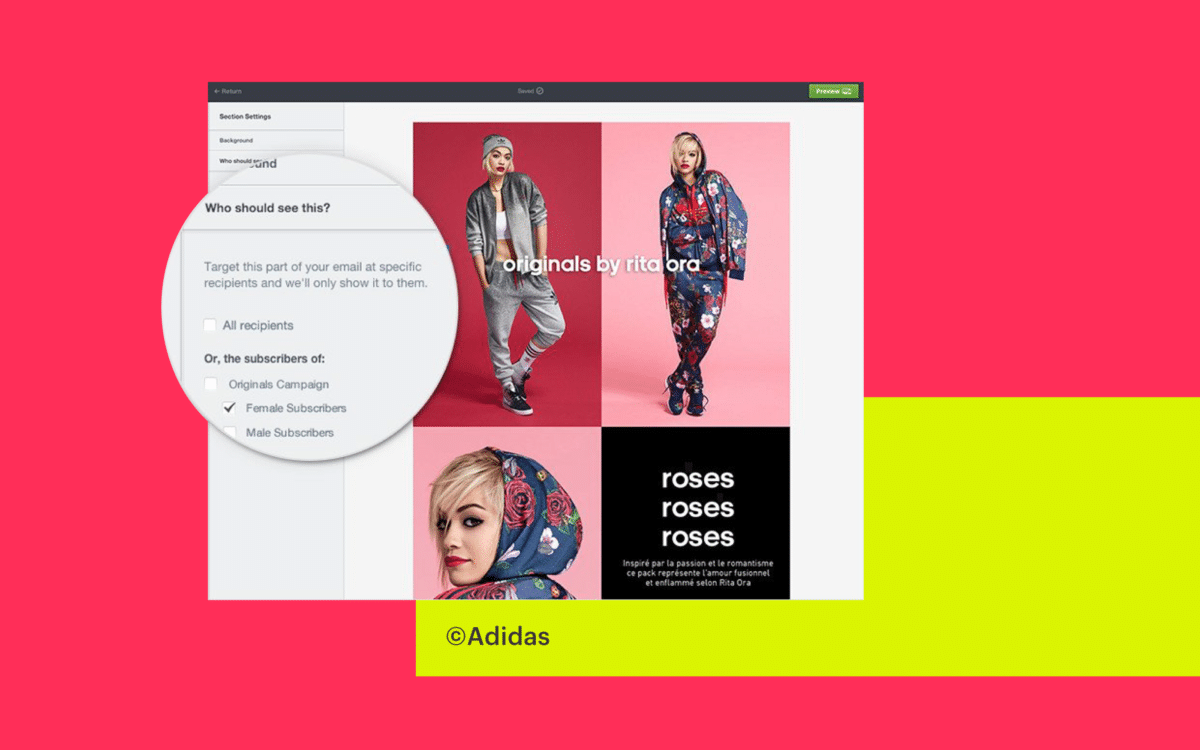
Companies that know how to use drip email campaigns effectively can even add personalized dynamic content to each message. With dynamic content, the nature of your email changes slightly to suit the specific profile of your customer.
You could even make suggestions on which products they should check out next based on items they’ve bought before.
Are drip campaigns tougher to make?
One of the reasons that companies often prefer to use one off email blasts when they’re first getting started with eMarketing, is that they’re a lot simpler to make. You don’t have to plan your customer’s full purchasing journey from start to finish with an email blast.
You can address your consumers at a specific point in time, ignoring the long-term relationship.
Successful email campaigns, on the other hand, require you to think carefully about everything from the exact timing of your email, to what order you send your messages in will affect your connection to your client. There’s a lot of planning involved.
The good news? Drip campaigns are becoming a lot easier to access, thanks to automation tools online. With marketing automation tools, you can build your entire email strategy with the same branded template and follow a specific schedule for connecting with your audience.
You can even set specific triggers, like deciding that an email campaign should start right after your customer signs up for your newsletter and agrees to your GDPR rules.
Email marketing automation tools take a lot of the headaches out of email marketing, but they still don’t make your campaigns into “set it and forget it” strategies.
You’ll need to:
Segment your target audience
Segmenting your audience based on specific characteristics will help you to determine which customer should get what kind of message, and at which time.
Design attractive emails
You can use the templates that come with your email marketing service to help you, but you still need to create the content. It’s up to you to include branded photos and create content that appeals to your customer.
Plan your campaigns
How many emails should you send to your customer informing them about your brand and products before you send your first promotional message? How often do you need to send marketing messages, and when should you give your customers a break?
Track your results
Tracking your email marketing metrics will help you to decide whether you’re sending your emails at the right times, or whether your subject lines are working to generate audience attention. The more you evaluate your campaigns, the easier it will be to optimize them over time.
Foster customer loyalty
Keeping an eye on your email marketing results will make it easier for you to see whether your campaigns are generating the right results in terms of loyalty. However, it’s also worth listening to the feedback you get from your customers.
If you start to get complaints about people receiving emails too often, give them the chance to reduce your marketing frequency.
Adjust your emails over time
As you gather more data about your target audience, you’ll need to adjust your messages, triggers, and automation sequences based on what you learn. Don’t let your emails become stale.
Remember to keep track of which customers aren’t engaging with your emails too. Clearing up your email list and removing disengaged customers can save you a lot of time and budget.
Use email marketing campaigns to foster loyalty
Email marketing blasts sent as a one-off message are a great way to share information with your audience fast. They can help you to announce random sales and give you a way to keep consumers informed about what’s going on in your business.
However, it’s the drip-based email marketing campaigns that have a bigger impact on your brand in the long-term. These are the messages that you can personalize according to the needs of your target audience and adapt according to their purchasing journeys.
With your email marketing software, and analytics systems to track data, your campaigns can become more effective over time.
Eventually, practice and commitment will leave you with a series of funnels that you can use to generate everything from brand advocacy to extra sales.
You could even create an entirely new segment of customers and transform them into your loyal supporters or “VIPs” – the people who get extra discounts in exchange for ongoing commitment to your brand.
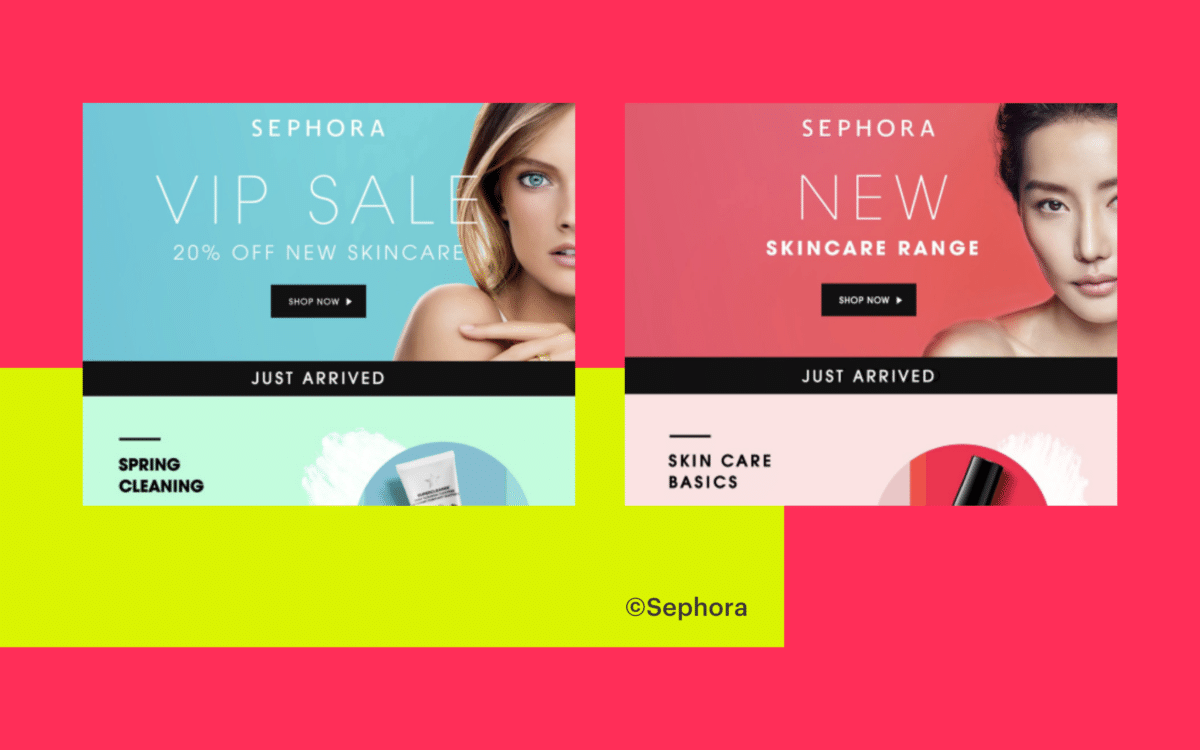
From time to time, you might still send a single blast for information reasons, but it’s your campaigns that will help your audience to fall in love with your company.
Fabrik: A branding agency for our times.
Now read these:

















